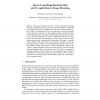Free Online Productivity Tools
i2Speak
i2Symbol
i2OCR
iTex2Img
iWeb2Print
iWeb2Shot
i2Type
iPdf2Split
iPdf2Merge
i2Bopomofo
i2Arabic
i2Style
i2Image
i2PDF
iLatex2Rtf
Sci2ools
100
click to vote
ECCV
2008
Springer
2008
Springer
Sparse Long-Range Random Field and Its Application to Image Denoising
Many recent techniques for low-level vision problems such as image denoising are formulated in terms of Markov random field (MRF) or conditional random field (CRF) models. Nonetheless, the role of the underlying graph structure is still not well understood. On the one hand there are pairwise structures where each node is connected to its local neighbors. These models tend to allow for fast algorithms but do not capture important higher-order statistics of natural scenes. On the other hand there are more powerful models such as Field of Experts (FoE) that consider joint distributions over larger cliques in order to capture image statistics but are computationally challenging. In this paper we consider a graph structure with longer range connections that is designed to both capture important image statistics and be computationally efficient. This structure incorporates long-range connections in a manner that limits the cliques to size 3, thereby capturing important second-order image sta...
Capture Important Image | Computer Vision | Conditional Random Field | ECCV 2008 | Image Statistics | Important Second-order Image | Markov Random Field |
| Added | 15 Oct 2009 |
| Updated | 15 Oct 2009 |
| Type | Conference |
| Year | 2008 |
| Where | ECCV |
| Authors | Yunpeng Li, Daniel P. Huttenlocher |
Comments (0)

